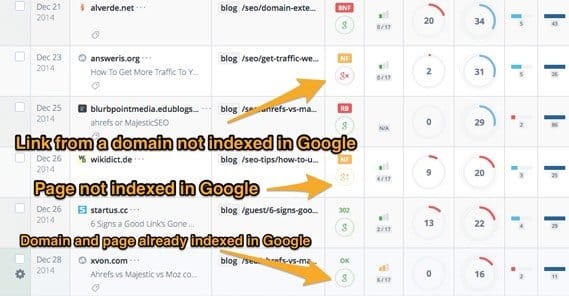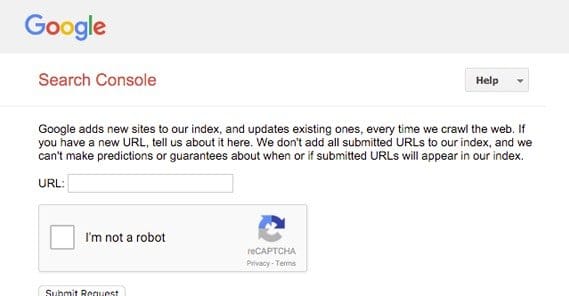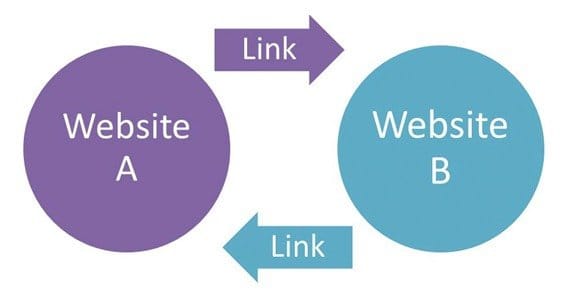How to Get Your New Backlinks Indexed As Fast as Possible

Backlinks make the world go round, at least in terms of search. As much as Google has tried to downplay them a little in recent years, they’re still a core foundation to the Internet and a primary way everything works, from traffic to advertising to discovery to shopping. Thus, links are important, no matter how much Google tries to make other things more relevant.
If you get 100 backlinks from unique, high quality domains, that’s good, right? Well, what about times when the sites those links are on don’t seem to have been indexed yet. You don’t get any search value from those links until the pages containing those links are indexed.
Note that this is distinct from getting your own content indexed. When you’re focusing on your own content, you have plenty of ways at your disposal to get them indexed. Links, though, aren’t your content. They’re not published on your site. You need to figure out how to get them indexed without needing access to the originating site, so you can claim your value. We marketers subsist on that sweet, sweet link juice, that nectar from the big G, and we want it now.
First Things First
Before you go about deciding to campaign to index a backlink, investigate it. Make sure that link is something you really want to keep around. Not all links are created equal, after all. Some links may not be valuable even if you get them indexed, while others can be actively detrimental.
First, check to make sure the site is relevant to your content. If they’re linking out of context, if the link is on a spam site, or the content is placed in an unorthodox location, you’re running the risk of earning negative value from the link. It’s better to either contact the webmaster and ask to have it removed, or put it on a list to send to Google for disavowal later on down the road.
Second, you will want to check out the presence of the site online. Is it a site that exists? That seems like an odd question to ask, but I’m talking about form Google’s perspective. Run a site search by using site:www.thatsiteURL.com so you can see what pages of the site are indexed. For one thing, you need to make sure the site is actually indexed. For another, you want to see what other content may be indexed and if it’s still relevant to your niche. A blog post about furniture on a site with 100 other posts dedicated to baseball isn’t going to do much good for your furniture store, after all.
After that, I would recommend checking the search ranking and other metrics of the site. Search ranking isn’t going to be a generic number you can check, but you can run some queries to see if they show up. More importantly, though, check out metrics you can find through Moz’s Open Site Explorer to check domain authority and page authority, or Majestic’s link authority. Check to make sure the site isn’t part of some weird private network that could get you demoted as part of it if you’re seen as a recipient.
While you’re at it, make sure the new link isn’t coming from copied or stolen content. This won’t hurt you, but it means the link isn’t very valuable at all, even if it’s coming from otherwise relevant-looking content.
There’s one more trick you might want to check, though it’s not always applicable. Check the robots.txt file in the root domain of the site hosting the link. Make sure they aren’t disallowing indexing of the pages they use. Chances are, though, if you found the link in the first place, you found it through an analytics suite, which pulls data from search engines, which means it can – and may already be – indexed.
Fringe Method: Fetch as Google
This method only works when you control the site that is linking to your other site. Google has a function called Fetch as Google, which you can find here. It essentially co-opts Google’s web crawler script and makes it fetch the page you point it at, so you can see what the page looks like to Google.
This is an invaluable testing tool, because you can use it to make sure your design or content can be viewed without a script breaking and hiding it. However, there’s also the sneaky little side benefit that sometimes the Googlebot will ferry data back to Google’s index. Using the Googlebot to fetch the page containing the link you want indexed may send that data back to Google, indexing the link immediately – or as immediately as Google ever is, anyways.
The problem here is two-fold. First, you can only fetch a page as the Googlebot if you own the page. If you’re not a verified owner of the page, you won’t be able to fetch it. Secondly, there’s no guarantee that the data will actually make it back to Google, or that it will result in indexing. That’s why this is a fringe method and not an actual method.
Submit Link URL
You probably knew this method would be on the list, and that’s because it’s probably the most effective way to get any page indexed, whether or not you own it. It’s simple; Google provides a form you can fill out to get a page submitted to the index. It’s a very simple form. You just need to paste in the URL and click the “I’m not a robot” button. Then click “submit request” to submit your request and wait for the request you submitted to be reviewed by the team that reviewed submitted requests.
There aren’t really any tricks, gimmicks, or restrictions to this system. You have to submit one URL at a time, so this isn’t great for bulk indexation requests, but you probably won’t be in that situation anyways. If you’re in the position to be receiving dozens or hundreds of backlinks in the space of a day, you’re doing just fine without getting them indexed faster than normal.
The caveat to this method is that it is not guaranteed. As they say on that page, “We don’t add all submitted URLs to our index, and we can’t make predictions or guarantees about when or if submitted URLs will appear in our index.” In other words, if the site doesn’t meet indexation criteria it won’t be indexed, and even if it does, it might not be indexed right away.
Frankly, this method is used by just about everyone starting a site, plus a million black hat marketers looking to squeeze every hour they can out of sites that are scheduled for demolition. The queue is probably a mile long. Still, it takes literal seconds to submit, so it can’t hurt to do it on your way to other things.
Tweet
This is another pretty simple method; just tweet the link. Google keeps a close eye on Twitter, though it’s not a completely comprehensive feed like it was back when they were integrating the firehose into Google Live Search. That’s a whole big thing, you can research it later if you don’t know what I’m talking about. In any case, Google likes to get data from Twitter whenever possible, and will index links it sees.
Thankfully, there’s more to Twitter than just an indexation tool. By tweeting a link, you are opening yourself up to a number of different benefits.
- Tweeting a link brings in engagement, as your followers may like the content of the link and will retweet it or like the tweet itself.
- Tweeting a link sends traffic to the page linking to you, which boosts the visibility of the site linking to you, which in turn helps pass on more value to your site.
- Tweeting a link that doesn’t point at your site helps round out your feed and boost your impression as a content curator and thought leader in your industry, rather than someone who just uses Twitter to promote themselves.
- Tweeting a link attracts the attention of the site owner and works as a way to show your appreciation for the link. That site owner is more likely to link to you in the future because you are proven to tweet their links.
Of course, Twitter only works on a small to moderate scale. If you have hundreds of links to tweet, you’ll end up doing it over the course of a year or more, because if you tweet too much people will start to look at you as a spammer.
Other Social Comments
In addition to tweeting, you can use other forms of social engagement on the web to boost the visibility of any page that isn’t deindexed for being spam. They all come with more or less the same benefits as Twitter, too, so you can gain audience, credibility, and traffic through sharing links that benefit you.
- Facebook page posts are a good option for all of the same reasons as Twitter. Just don’t pay to promote one; the link is on a page you don’t own, generally, so why pay to send traffic to someone else?
- Google+ posts are amazing for this because Google also pays attention to their social media feeds as a source of index data. Simply posting a link on Google+ is akin to submitting it via the URL submitter listed above. It can be picked up and indexed quickly just from that.
- Reddit posts are great because they have the potential to go viral very easily. The trick to using Reddit is to find the appropriate subreddit to submit the link to without being flagged as an advertiser or spammer. You do have the benefit that you’re sharing a link that isn’t yours, so as long as your username and the link in the post you share don’t match, you’re good to go. If they do match, you run the risk of someone noticing you only share links to pages that link to you, and blaming you for advertising.
I don’t recommend trying to use blog comments or forum posts for this. At that point, you’re digging into gray hat link building and the owner of the site linking to you might not appreciate it. They can probably draw the connection between the link and you, and will be less likely to support you in the future. It all depends on the blog owner, though, so you might take your chances.
Link Your Links
Reciprocal links are dangerous because Google treats them as a black hat technique, but that’s specifically due to one type of spam.
Essentially, there are massive networks of link exchanges out there that spin reciprocal links throughout huge networks of sites. This means your link ends up on dozens or hundreds of spam sites, while you link back to those sites in exchange. That’s not what you’re doing in this case, so it’s much more potentially beneficial.
The keys to reciprocal links are two-fold. First, make sure the site passes the filters up top. No matter how well you index it, a link from a spam site is still a bad link. Second, make sure the link back to the blog post linking to you is not on the same post they’re linking to. Page 1 on site A linking to page 1 on site B – your site – is good. To reciprocate, send a link from page 2 on site B to page 1 on site A; a link being returned to the page you want indexed, but not from the page being linked to.
Once you have that reciprocal link in place, you can put all the various indexing methods to work on your own site to index the post that contains a link to the post that links to you, in a daisy chain of value.
The one final key to reciprocal links should be obvious, but I need to state it anyway; don’t reciprocate every link that comes into your site. A few reciprocal links are good. I link to Quicksprout all the time, and they link back to me; that’s not reciprocal link building in a bad way, that’s two marketers promoting value they see in each other. It’s not a 1:1 trade, it’s not every link, and it’s not artificial. No money changes hands for it, no communication is needed; it’s all organic.
Just Wait
The final tip is a basic one, because this is a basic subject. Google is pretty good about indexing links of any value. Sure, they might only index 25% of the links that exist pointing at your site, but those remaining 75% could be coming from negative SEO, spam sites, or other detrimental sources and are ignored for a good reason.
If the site that is linking to you is itself indexed, most of the time any new page it creates is going to be indexed within a day or two. Sometimes, that indexation will occur within a couple hours. It all depends on how proactive the site owner is and how high value the site is. All you really need to do to get your link indexed is wait.
Final Note: Beware of Tools
There are a lot of tools, like BacklinksIndexer, that exist in a space that convinces you they index your links quickly. The thing is, that’s not quite what they do. They’re automated link building apps, which means they submit your link to blog directories, forums, blog comments, and a thousand other places. They’re more of a set of spam tools than they are legitimate means of getting your backlinks indexed. Even worse, if you point it at someone who is linking to you, you might get them penalized for building unnatural links. That penalty can flow along the link to you, not only devaluing the link you were trying to value, but harming you and your reputation in the process.
The opposite side of the coin here is a service like OneHourIndexing. This service uses Google-based methods for submitting links, and it does it in a way that’s as safe as can be as long as you’re not building thousands of links at once. It’s not a spam submitter and it’s not a private blog network; it’s just a unique service that costs some cash to prioritize indexing your links. Does it work? Sure. The only question is, how much value can you make out of it? There are other similar services, but always be cautious when using any one of them, including OHI. They’re quite often double-edged blades that can hurt as much as help if you use them incorrectly.
 ContentPowered.com
ContentPowered.com









